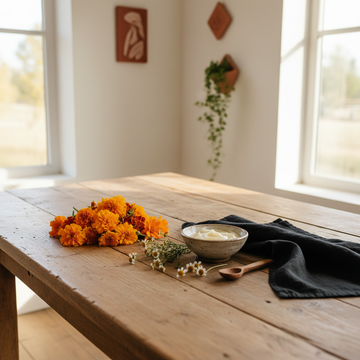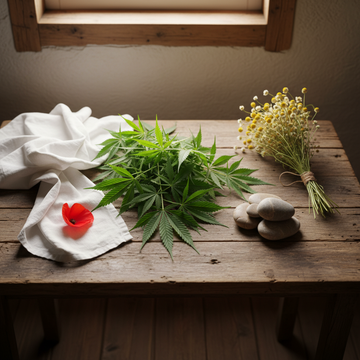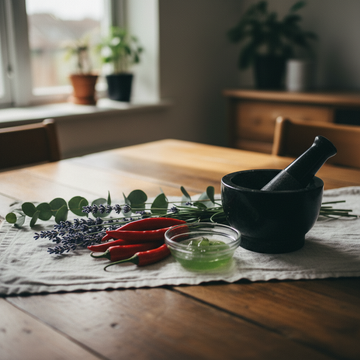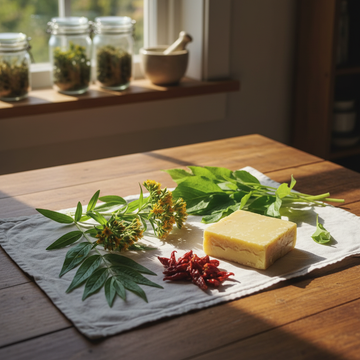Understanding and naturally relieving osteoarthritis: Your path to a better quality of life
Millions of people in Germany live with osteoarthritis – but the good news is: There are proven, natural ways to relieve symptoms and support joint health. As Jiri Studnicky, founder of H4H Naturals, I share with you the knowledge I learned from my grandmother – a pharmacist who lived to be 102 – combined with modern scientific findings.
Key Takeaways
- Millions of people in Germany live with osteoarthritis, but there are proven natural methods to relieve the symptoms.
- Natural ways can effectively support joint health and improve quality of life.
- The knowledge is based on traditional experience combined with modern scientific findings.
- Jiri Studnicky, founder of H4H Naturals, shares valuable insights he received from his grandmother, a long-time experienced pharmacist.
Table of Contents
- Understanding and naturally relieving osteoarthritis: Your path to a better quality of life
- What is osteoarthritis? Understanding the basics
- Why osteoarthritis is such an important topic
- Which joints are typically affected?
- How does osteoarthritis develop? Understanding the process
- Symptoms and course of the disease: What you can expect
- Osteoarthritis vs. Arthritis: Understanding the Important Differences
- Causes and risk factors: What promotes osteoarthritis?
- Diagnosis: How is osteoarthritis diagnosed?
- Therapy & Treatment Options: What Really Helps with Osteoarthritis
- Self-help & prevention: Successfully managing osteoarthritis in everyday life
- The future of natural osteoarthritis treatment
- Conclusion: Treat osteoarthritis holistically and sustainably
Short answer
What really helps with osteoarthritis: A combination of an anti-inflammatory diet, joint-friendly exercise, natural pain relievers such as hemp extract and willow bark, and targeted weight management. Studies show that natural approaches can reduce symptoms by up to 40% without the side effects of synthetic painkillers.
What is osteoarthritis? Understanding the basics

Osteoarthritis is the most common joint disease worldwide, affecting approximately 5 million people in Germany. Osteoarthritis is a degenerative joint disease in which the cartilage between the joints gradually breaks down , leading to pain, stiffness, and limited mobility.
Osteoarthritis at a glance:
- Mainly affects knees, hips, hands and spine
- Usually begins at the age of 45
- Women are more often affected than men
- Causes over 2 billion euros in treatment costs annually
Primary vs. secondary osteoarthritis: The important differences
| criterion | Primary osteoarthritis | Secondary osteoarthritis |
|---|---|---|
| Caused | Natural aging process | Injuries, misalignments, illnesses |
| Age at start | Mostly from 50 years | Can occur at any age |
| Affected joints | Several joints symmetrical | Mostly individual joints |
| Course | Slowly progressing | Can progress faster |
Why osteoarthritis is such an important topic
Current studies show that osteoarthritis is not only a medical problem, but also a social one. The disease leads to:
- Reduced quality of life: 78% of those affected report daily pain
- Work absences: Osteoarthritis causes 25% of all early retirements due to illness
- High treatment costs: an average of 3,200 euros per patient annually
- Social isolation: Restrictions on movement often lead to withdrawal from social activities
"In my family, we've learned over generations that nature often provides the best answers to our health problems. My grandmother successfully treated joint pain with willow bark, comfrey, and other medicinal plants—methods that are now confirmed by modern research." – Jiri Studnicky, H4H Naturals
Which joints are typically affected?

Osteoarthritis does not occur with the same frequency everywhere. Certain joints are particularly vulnerable due to the stress they are subjected to:
Knee osteoarthritis (gonarthrosis) - 60% of all cases
The knee joint bears our entire body weight and is therefore particularly vulnerable. Excess weight significantly increases the strain: every additional kilogram means 4 kg more pressure on the knee joint when walking.
Hip osteoarthritis (coxarthrosis) - 25% of all cases
In cases of hip osteoarthritis, early exercise therapy is recommended because the hip joint is surrounded by strong muscles that can have a stabilizing effect.
Hand and finger osteoarthritis - 15% of all cases
Particularly common in postmenopausal women, Heberden's nodes on the distal interphalangeal joints are a typical symptom.
Important note on natural treatment:
Natural approaches such as hemp extract-based ointments can provide support for all forms of osteoarthritis. Our dermatologically tested formulations with organic hemp seed oil and CO₂ extracts offer a gentle alternative to synthetic painkillers – without their side effects. Those interested in proven products can find a selection of our best-selling natural osteoarthritis relief directly in our shop.
How does osteoarthritis develop? Understanding the process
You may be wondering how healthy joints become painful and stiff. Osteoarthritis is caused by an imbalance between cartilage degradation and cartilage formation , with cartilage degradation predominating.
- Cartilage damage: Overload, injuries or age cause the first cracks in the cartilage
- Inflammatory reaction: The body reacts with chronic, low-grade inflammation
- Cartilage degradation: Enzymes break down damaged cartilage faster than new cartilage is formed
- Bone changes: The exposed bone thickens and forms osteophytes (bone growths)
- Joint capsule inflammation: The synovial membrane becomes inflamed, leading to swelling and pain
A hopeful finding: Studies show that this process is not unstoppable. Through targeted natural measures, we can support cartilage metabolism and reduce inflammation. Certain plant substances, such as the cannabinoids contained in our organic hemp extract, have anti-inflammatory effects and can promote regeneration.
Symptoms and course of the disease: What you can expect

Osteoarthritis develops gradually over years. The first signs are morning stiffness and pain when starting to move, which can develop into persistent symptoms.
Recognize early symptoms and warning signs
The first signs of osteoarthritis are often subtle and frequently overlooked. Early detection is crucial for successful natural treatment , as cartilage degradation can still be slowed in the early stages.
The 5 most important early warning signs:
- Starting pain: Pain when getting up for the first time after a long period of rest
- Morning stiffness: Joints feel "rusty" (5–30 minutes)
- Weather sensitivity: Symptoms worsen in cold weather or changes in air pressure
- Crunching noises: Crepitation when moving the joints
- Slight swelling: especially visible after exertion
Typical symptoms and their course
There are three main stages of osteoarthritis, each requiring specific symptoms and treatment approaches:
| stage | Main symptoms | Duration of symptoms | Natural treatment |
|---|---|---|---|
| Early stage | Starting pain, slight stiffness | A few minutes to hours | Exercise, anti-inflammatory diet |
| Middle stage | Pain on exertion, restricted movement | Several hours a day | Hemp extract ointments, heat therapy |
| Late stage | Pain at rest, significant deformation | Persistent, even at night | Holistic pain therapy necessary |
"My grandmother always said, 'The body whispers first, then speaks, and finally screams.' It's the same with osteoarthritis – the sooner we take the subtle signals seriously, the better we can counteract it with natural remedies." – Jiri Studnicky, H4H Naturals
When should you see a doctor?
Immediate medical consultation in case of:
- Sudden, severe joint pain
- Redness, overheating or severe swelling
- Pain that lasts longer than 6 weeks
- Restrictions in everyday life
- Night pain that disrupts sleep
Osteoarthritis vs. Arthritis: Understanding the Important Differences
You may be wondering why this distinction is so important. Osteoarthritis and arthritis are often confused, but they require completely different treatment approaches . A correct diagnosis is crucial for choosing the right natural therapy.
| criterion | Osteoarthritis | Arthritis (e.g. rheumatoid arthritis) |
|---|---|---|
| Caused | Cartilage wear due to wear and tear | Autoimmune reaction against joints |
| Course | Slowly progressing over years | In phases, can progress quickly |
| Affected joints | Large joints (knees, hips, spine) | Small joints (fingers, wrists) |
| Signs of inflammation | Low, locally limited | Strong, systemic |
| Morning stiffness | Under 30 minutes | Over 1 hour |
| Age at start | Mostly from 50 years | Often between 30–50 years |
Practical differentiation aid:
In osteoarthritis, symptoms usually improve with moderate exercise, whereas in inflammatory arthritis, they often worsen with activity. Our natural hemp extract formulations can support both forms, as they offer both pain relief and anti-inflammatory properties.
Causes and risk factors: What promotes osteoarthritis?
Osteoarthritis is not just an inevitable sign of aging. Various factors influence the risk of developing osteoarthritis – and we can actively influence many of them .
Understanding cartilage wear and joint changes
Articular cartilage is a fascinating tissue: It contains no blood vessels and is nourished exclusively by synovial fluid. This "lubrication" only functions optimally with regular, moderate exercise.
The 7 most important risk factors
- Obesity (largest controllable factor): Every kilogram of additional body weight increases the risk of osteoarthritis by 9–13%
- Injuries and trauma: Cruciate ligament tears or meniscus damage increase the risk by 5–7 times
- Misalignments: X- or O-legs lead to uneven load
- Occupational stress: Heavy physical work, especially with knee strain
- Genetic predisposition: 40–60% of the risk of osteoarthritis is hereditary
- Gender: Women are 2–3 times more likely to be affected, especially after menopause
- Lack of exercise: "Use it or lose it" – immobile joints wear out faster
Factors that can be influenced
- Reduce body weight
- Regular, joint-friendly exercise
- Anti-inflammatory diet
- Ergonomic workplace design
- Natural pain relief
Factors that cannot be influenced
- Genetic predisposition
- Gender
- Old
- Injuries already sustained
- Congenital malpositions
The role of chronic inflammation
Osteoarthritis is not just a mechanical deterioration, but also an inflammatory process. Chronic, low-grade inflammation significantly accelerates cartilage degradation . This finding opens up new possibilities for natural treatment approaches.
Scientific finding: Studies show that certain inflammatory markers (such as IL-1β and TNF-α) are elevated years before the first symptoms appear. Natural anti-inflammatories like the cannabinoids in our organic hemp extract can have a preventative effect.
Diagnosis: How is osteoarthritis diagnosed?
Diagnosing osteoarthritis is often a multi-step process. An early, accurate diagnosis enables the timely implementation of natural therapeutic approaches before irreversible joint damage occurs.
History and physical examination
The first and most important step: An experienced physician can often make a suspected diagnosis of osteoarthritis simply through questioning and a physical examination. Typical tests include:
- Pain history: When, where and under what circumstances does pain occur?
- Mobility test: measuring the range of motion
- Palpation: swelling, overheating, tenderness
- Functional tests: gait, stair climbing, grip strength
Imaging techniques: What do X-rays, MRI, and CT show?
| Proceedings | Shows | Advantages | Limits |
|---|---|---|---|
| roentgen | Bone changes, joint space | Fast, cost-effective | Cartilage not visible |
| MRI | Cartilage, soft tissue, inflammation | Very detailed | Expensive, time-consuming |
| Ultrasonic | Joint effusion, inflammation | Radiation-free, cost-effective | Limited depth representation |
"It's important to understand: X-rays often show more wear and tear than symptoms, or vice versa. The patient's symptoms are always the focus – not the image. That's why at H4H Naturals, we focus on a holistic approach to body and mind." – Jiri Studnicky
Laboratory values: When are they useful?
You may be wondering whether blood tests are necessary for osteoarthritis. Laboratory tests primarily serve to rule out inflammatory joint diseases , since osteoarthritis itself doesn't cause characteristic blood values.
Important laboratory parameters for differential diagnosis:
- CRP and ESR (inflammatory markers) – usually normal in osteoarthritis
- Rheumatoid factor and anti-CCP – to rule out rheumatoid arthritis
- Uric acid – if gout is suspected
- Vitamin D3 levels – important for bone health
Therapy & Treatment Options: What Really Helps with Osteoarthritis
Many years of experience in naturopathy show that the most effective treatment for osteoarthritis combines various natural approaches . Individual measures often show only limited success, whereas a holistic therapeutic approach achieves significantly better long-term results.
Lifestyle changes: The foundation of any successful osteoarthritis treatment
Lifestyle changes can have a greater impact on the course of osteoarthritis than many medications. The three pillars are weight management, targeted exercise, and an anti-inflammatory diet.
Advantages of natural therapeutic approaches
- No side effects when used correctly
- Long-term improvement in quality of life
- Strengthening the entire musculoskeletal system
- Positive effects on other health areas
- Sustainable and cost-effective
challenges
- Results only appear after weeks or months
- Requires consistent cooperation from the patient
- Individual adaptation of therapy necessary
- Limited effectiveness in advanced osteoarthritis
Nutrition for osteoarthritis: Inflammation control from within
What we eat directly influences the inflammatory processes in our joints. A targeted, anti-inflammatory diet can reduce osteoarthritis pain by 20–40% – with no side effects.
| Food group | Recommended | To avoid | Effect |
|---|---|---|---|
| Fats | Omega-3 (hemp seeds, linseed oil, walnuts) | Trans fats, excessive omega-6 | Inflammation regulation |
| Proteins | Fish, legumes, hemp protein | Processed meat | Cartilage formation |
| Carbohydrates | Whole grains, vegetables, berries | sugar, white flour | Blood sugar stability |
| Spices | Turmeric, ginger, hemp extract | Excessive salt | Natural anti-inflammatory |
"My grandmother used hemp seeds as 'joint food,' as she called it. Today we know: The omega-3 fatty acids and gamma-linolenic acid in hemp are scientifically proven anti-inflammatory agents. Our organic hemp oils contain these nutrients in optimal concentrations." – Jiri Studnicky
Dietary supplements: Glucosamine, Chondroitin & natural alternatives
Not all dietary supplements for osteoarthritis are equally effective. The evidence varies greatly between different substances.
- Hemp extract with CBD (highest evidence): Studies show 30–50% pain reduction with daily use
- Omega-3 fatty acids: EPA/DHA at least 1000 mg daily for anti-inflammatory effects
- Turmeric extract: With piperine for better bioavailability, 500–1000 mg daily
- Glucosamine/Chondroitin: Mixed study results, possibly effective in mild osteoarthritis
- Vitamin D3: Deficiency worsens osteoarthritis, 1000–2000 IU daily
Important note on quality:
When it comes to dietary supplements, quality is crucial. Our organic hemp extracts undergo triple laboratory testing and contain standardized amounts of active ingredients – unlike many cheap products without quality control. Those interested in other natural alternatives will find fascinating information in our article on devil's claw ointment .
Movement & Exercises: The Key to Pain Relief
You may be wondering how exercise can help with joint pain. Paradoxically, controlled exercise is the most effective "medicine" for osteoarthritis pain —when dosed correctly.
The 3 best joint-friendly sports:
- Swimming/Aqua Fitness: 90% weight relief, ideal joint mobility
- Cycling: Strengthening without impact, individually adjustable
- Nordic Walking: Natural movement with poles for relief
Medications & alternative procedures in comparison
| Treatment | effectiveness | Side effects | Cost | sustainability |
|---|---|---|---|---|
| NSAIDs (ibuprofen etc.) | High (short term) | Stomach, heart, kidneys | Low | Small amount |
| Hemp extract ointments | Medium-High | Very low | Medium | High |
| Hyaluronic acid injections | Variable | Small amount | High | Medium |
| acupuncture | Medium | Very low | Medium | High |
Self-help & prevention: Successfully managing osteoarthritis in everyday life
Everyday life with osteoarthritis is definitely worth living – if you know the right strategies. Small adjustments can make a big difference in your quality of life . If you're interested in more tips, you'll find our most popular self-help products clearly listed in our Best Sellers section .
Weight control and practical exercise tips
Every kilogram of weight loss relieves 4 kilograms of strain on the knee joints with every step. A 5 kg weight loss equates to 20 kg less strain per step—a tremendous relief over the course of a day.
- Morning ritual: 10 minutes of gentle joint movements before getting up
- Workplace: Get up and move every 30 minutes
- Climbing stairs: Slowly and with railings, step by step
- Hemp extract massage: Massage affected joints for 5 minutes in the evening
Aids and ergonomic everyday tips
Dealing with psychological stress
Chronic pain not only burdens the body but also the mind. Up to 30% of osteoarthritis patients develop depressive moods —a vicious cycle that can be broken.
Proven strategies for combating osteoarthritis-related depression: Regular exercise (even when in pain), maintaining social contacts, learning relaxation techniques, and seeking professional help if necessary.
The future of natural osteoarthritis treatment
We are at the beginning of a new era in osteoarthritis therapy. Personalized, natural treatment concepts are increasingly supported by scientific evidence . Those interested in current studies and modern approaches will find further information on osteoarthritis medications and studies on this page .
Promising developments:
- Genetic tests to determine the optimal hemp extract dosage
- Microbiome analysis for personalized nutritional recommendations
- AI-supported movement therapy apps
- Sustainable extraction of active ingredients from seaweed and fungi
Frequently Asked Questions
What is osteoarthritis?
Osteoarthritis is a degenerative joint disease in which the protective cartilage in the joints gradually wears away. This leads to pain, restricted movement, and inflammation, especially in heavily stressed joints such as the knees, hips, or hands.
Which ointment helps with osteoarthritis?
For osteoarthritis, ointments with anti-inflammatory and pain-relieving active ingredients can help, especially those containing herbal extracts such as cannabis or hemp oil, mountain pine, or arnica. Our H4H Naturals ointments combine broad-spectrum hemp extracts with adaptogenic herbs to strengthen the skin barrier and promote local circulation, which can contribute to natural relief.
Can osteoarthritis be treated naturally?
Yes, osteoarthritis can be naturally supported through a combination of herbal supplements, exercise therapy, an anti-inflammatory diet, and targeted skin care. Our formulas utilize certified organic hemp extracts and adaptogenic botanicals that are clinically proven to relieve pain and promote joint function, without synthetic additives.
How long does osteoarthritis last?
Osteoarthritis is a chronic disease that develops over years and progresses differently from person to person. While cartilage damage cannot be reversed, consistent natural care and lifestyle adjustments can slow its progression and significantly improve quality of life.
What home remedies for osteoarthritis?
Home remedies for osteoarthritis include regular exercise, heat treatments such as warm baths or compresses, and the use of herbal oils and ointments with anti-inflammatory properties. In addition, tried-and-tested home remedies such as ginger or turmeric teas can help promote general well-being and reduce inflammation in the body.





